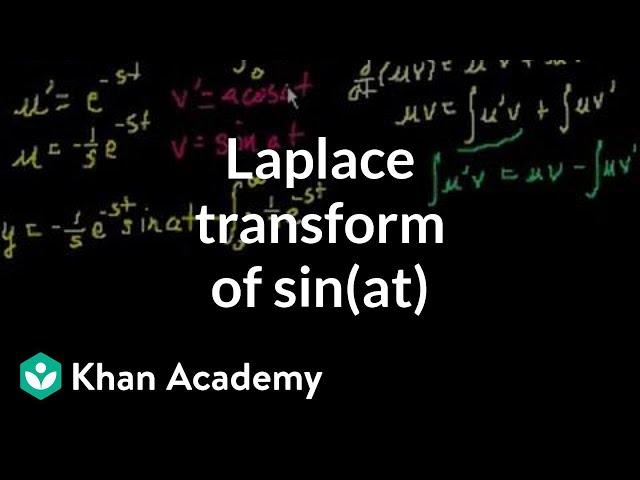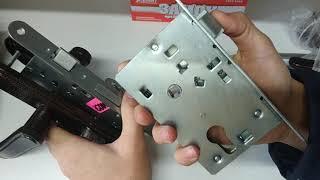
L{sin(at)}) - transform of sin(at) | Laplace transform | Differential Equations | Khan Academy
Комментарии:

Thank you
Ответить
ngl almost had a brain aneurism when he was explaining how to remember the integration by parts equation.
Ответить
Thank you very much sir for this ❤
Ответить
💜
Ответить
Hi Sal, thank u
Ответить
Sir, just how do you make everything looks so easy?
Ответить
i dont understand why are we using the product rule there
Ответить
the math you used to solve is quite different from what most of the ppl learned, got confused a lot from you. but thanks got the idea anyway
Ответить
13 years back and you’re still grooming future engineers like myself. I respect ✊
Ответить
Thanks
Ответить
all that writing and getting lost makes me hate this. thanks for doing it so I don't have to
Ответить
Isn't there a formula saying something like (the following is in latex)
\int{e^{ax} sin(bx+c) dx}=\frac{e^{ax}}{a^2 + b^2}{[a sin(bx+c) - b cos(bx+c)]}+k

I think the whole integral would be easier if we take laplace of e^iat ( as e^iat corresponds to cosat+sinat) then after finding the laplace of e^at as (s+ai)/s^2+a^2
we get a real(s/s^2+a^2 ) and a imaginary part( a/s^2+a^2). The real part corresponds to cos(at) thus L{cosat}=s/s^2+a^2 and L{sinat}=a/s^2+a^2.
credits: Dr. Pramita Roy, my maths lecturer

evergreen videos Sir, its 2021, you did something that will be here even we all will end at the end
Ответить
this is the only way im learning diff eq.
Ответить
I love he always says he will continue the materials later when he runs out of time, unlike my lecturers :)
Ответить
can yall update this, its really hard to see this video clearly
Ответить
The process of by parts is quiet different in our country. Its easy to remember.
Ответить
so nice video but my poor eyes. 240p
Ответить
Well, I will use my integration table without remorse after this one :D
Ответить
Who the hell does integration by parts as ∫vdu = uv - ∫udv? It's way more common to do ∫udv = uv - ∫vdu. Obviously they're the same thing but it's just confusing to switch them.
Ответить
Here’s a nice way to remember integration by parts. S(ydx) for some curve is the area between the curve and the x-axis and S(xdy) is the area between that curve and the y-axis, so if you add the areas you end up with the area of the rectangle it forms which is xy.
Ответить
Please use board.
Ответить
this guy been helping through high school. now I'm doing n6 and im back here
Ответить
it is very very clear persentation
Ответить
We can do this more simply by using. e^i(imaginary number).(theta) = Cos (theta) + i Sin (theta).
then using the concept and solve e^iat

B
Ответить
The higher up the ladder of Mathematics I climb, the bigger becomes the importance of keeping right track of everything you do, making sure you did everything in the proper order, and not making careless mistakes.
Ответить
That was one hairy problem
Ответить
u integral of(v) - integral of u'- integral of v = by parts
Ответить
somebody get this guy some glucose
Ответить
I believe u should be u' and vice versa.
Ответить
Why is U = -1/Se^-st and not e^-st
Ответить
Thanks for that video. However, you took the long way to get the Laplace transform of the (sin) function. That can be done in only three simple steps: (1) represent (sin at) in its exponential form (sin at=1/2j [e^(jat) - e^(-jat)] , (2) substitute (1) in the Laplace general equation, and (3) solve the integrals in their exponential forms.
Thanks again.

I think your parts formula is backwards
Ответить
I love it how Sal reminds us about the prereq calculus we need to understand the lesson. keeps me connected to the lesson.
Ответить
Thank you
Ответить
Your bi parts method is foreign to me.
Ответить
Would u plzz help me with laplace transform of sin√t
Ответить
isn't it uv-v(du) ?
Ответить
I give up
Ответить
why you take integration of U'V instead of Integration of UV' .
pls answer me sir

one can find the laplace transforms of sin(at ) and cos(at) at the same time.
L[ e^(at) ] = 1 / ( s - a )
L [ e^(i*bt )] = 1 / ( s - ib )
Recall that e^( i*theta ) = cos theta + i sin theta
L [ cos ( bt ) + i*sin ( bt ) ] = 1 / ( s - ib )
L [ cos ( bt ) ] + i * L [ sin ( bt ) ] = (s + ib ) / ( s^2 + b^2 )
L [ cos ( bt ) ] + i * L [ sin (bt ) ] = [s / ( s^2 + b^2 ] + i * [ b / ( s^2 + b^2 ) ]
so L [ cos (bt ) ] = s / ( s^2 + b^2 )
and L [ sin ( bt ) ] = b / (s^2 + b^2 )

Starting to see the purpose of this...NOT!!
Ответить
You could have used the Euler's rule instead of doing integration by parts.
Ответить
This playlist has saved my grade in Diff. eq. I just thought i would let you know that you are better at teaching than my professor. I can follow your train of thought, you don't make as many mistakes or algebra errors, and your videos are ordered in a way which parallels my course. How does one donate to Khan Academy?? I feel like I owe this page so much, I go through almost every subject that you cover. THANK YOU Sal for all of the knowledge you share with everyone! I'm sure that I am not the only one who owes their success to this channel. keep up the good work.
Ответить
Thank you Khan Academy, and especially Sal. You made this oh so simple 👍
Ответить
why not use Euler's Rule? sin(θ) = (e^(jθ) - e^(-jθ))/2j this shortens the solution. :) But thanks for the review on integration by parts.
Ответить
I think it is possible to use Euler identity in order to avoid that uv substitution.
Ответить

























